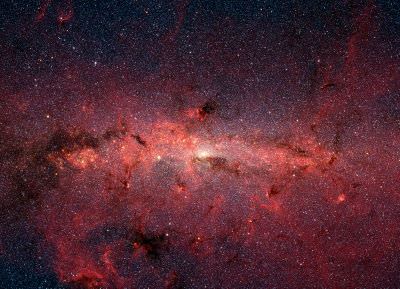We’re all used to seeing maps of the Milky Way rich with stars and nebulae. But, there are regions we can’t see or map using conventional methods. There’s no way to get outside the Galaxy to take pictures of the whole shebang.
According to Keith Hawkins of the University of Texas at Austin, we’re trapped inside the Milky Way and can’t get a bird’s-eye view. “It’s like being in a big city,” he explained. “You can look around at the buildings and you can see what street you’re on, but it’s hard to know what the whole city looks like unless you’re in a plane flying above it.”
To get around that limitation, Hawkins used a technique called “chemical mapping” or chemical cartography. It charts the places we can’t see using our powerful telescopes or regions for which we have only good models and simulations. “I wanted to find out how accurate those models and illustrations actually are,” he said. “And to see if chemical cartography could reveal a clearer view of the Milky Way’s spiral arms.”
Filling in the Milky Way Using Chemical Cartography
When you look at charts and images of the sky, the stars stand out. Most maps of the Milky Way take advantage of that property. Concentrations of young stars (in particular) stand out the most because they’re bright. They form in regions where the rotating spiral arms compress clouds of gas and dust. The result is batches of newborn stars. So, one of the easiest ways to map those arms is to look for new stars.

Wherever you have star birth, you also have their stellar crêches—clouds of gas and dust. And, those clouds often hide the new stars—and the galaxy arms—from our view. This is where chemical cartography comes in handy. It relies on knowing the metal content of stars. The first stars in the Universe (and the oldest stars in the Galaxy) are fairly metal-poor. That means they are mostly hydrogen and helium. As they died they scattered heavier elements such as carbon, oxygen, and so on (astronomers call them “metals”) to interstellar space. Those elements became part of the next generations of stars. Each subsequent batch of stars contains more complex metals than its “parent” generations.
Chemical cartography tracks the distribution of metal-rich stars in the Galaxy’s spiral arms, where young stars have higher metallicity content. In fact, astronomers have seen a “belt of metallicity” in the Galaxy that might be obvious to distant observers. So, in theory, Hawkins theorized that if you can track the metallicity of the stars in the arms that you can see, you can “fill in” the view of the spiral arms we can’t see.
Filling in the Chemical Maps of the Milky Way’s Arms
To test this idea, Hawkins analyzed data from the Large Sky Area Multi-Object Fibre Spectroscopic Telescope (LAMOST) and Gaia space telescope. Gaia has made incredibly precise and comprehensive surveys of the Milky Way, measuring more than two billion objects. Fortunately, Gaia’s data includes chemical composition measurements for about one percent of the Galaxy, which was enough data for Hawkins to use in his chemical cartography.

Hawkins first charted the distribution of metallicity in our Galaxy, beginning with the region around the Sun. There’s a lot of data for our local neighborhood—which ranged out around 32,600 light-years. He reasoned that areas with high metallicity in the stars should line up with the spiral arms. The less metal-rich stars should be in the regions between the arms.
Then, he compared it to other maps of the Milky Way. He found that the spiral arms in those charts lined up with the ones in his metallicity charts. Since his map showed the existence of spiral arms based solely on stellar metallicity (rather than starlight), new regions showed up. Those were places not mapped by other charts, probably because they aren’t easily visible.
“A big takeaway,” said Hawkins, “is that the spiral arms are indeed richer in metals. This illustrates the value of chemical cartography in identifying the Milky Way’s structure and formation. It has the potential to fully transform our view of the Galaxy.”
Knowing Our Galaxy from the Inside
While astronomers have known for decades that the Milky Way is a spiral galaxy, they’ve had a tough time filling in the exact shape of the arms and the core. These days, we know that it’s a barred spiral. The bar itself could be funneling gas in from the spiral arms to the core. There, it eventually gets caught up in waves of star birth activity.

We can’t always see the activity in the core, so chemical cartography could prove to be a very useful tool for mapping that region of the galaxy. Gaia’s ongoing mission of charting the Galaxy and providing even more chemical information about the stars of our galaxy will continue to help astronomers like Hawkins fill in our view of the Milky Way and its structures. “Much like the early explorers, who created better and better maps of our world, we are now creating better and better maps of the Milky Way,” says Hawkins. “Those maps are revealing things we thought to be true, but still need to check.”
For More Information
Chemical Cartography Reveals the Milky Way’s Spiral Arms
Chemical Cartography with LAMOST and Gaia Reveal Azimuthal and Spiral Structure in the Galactic Disk
Gaia Web Site

